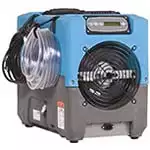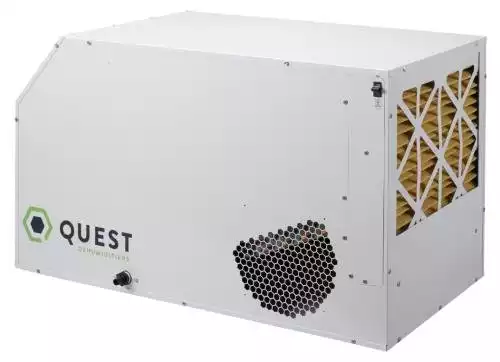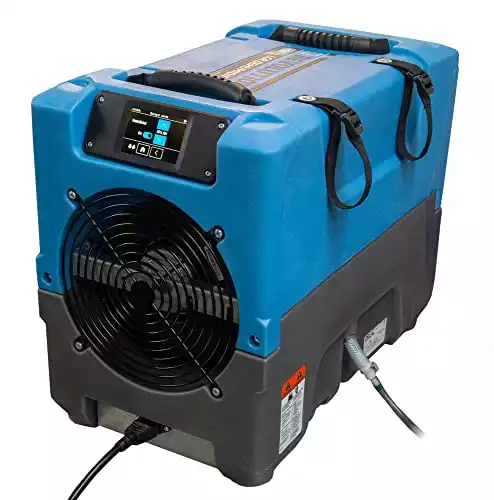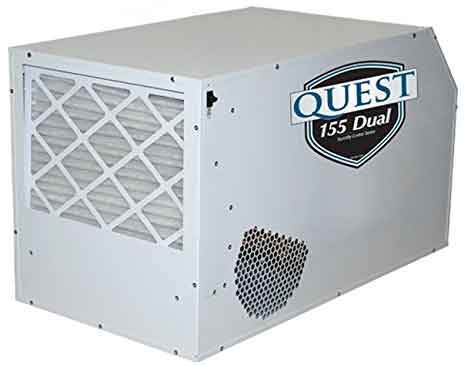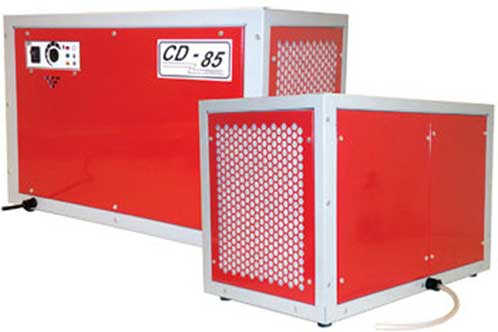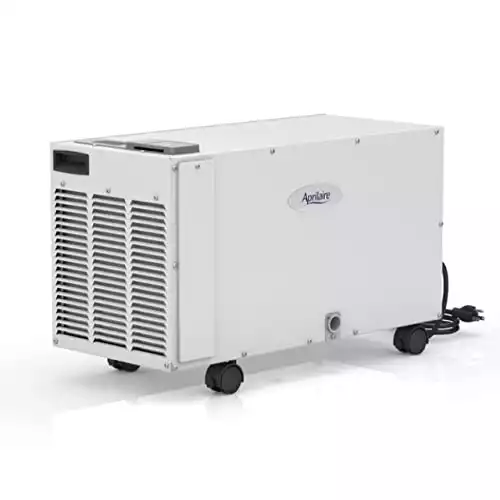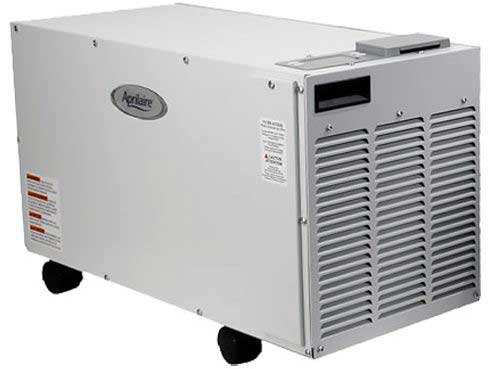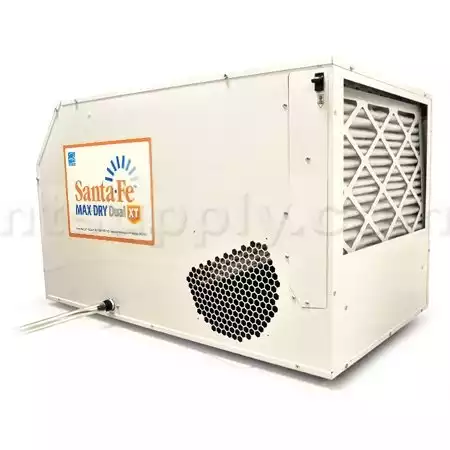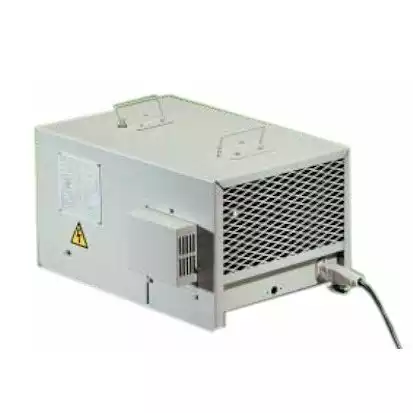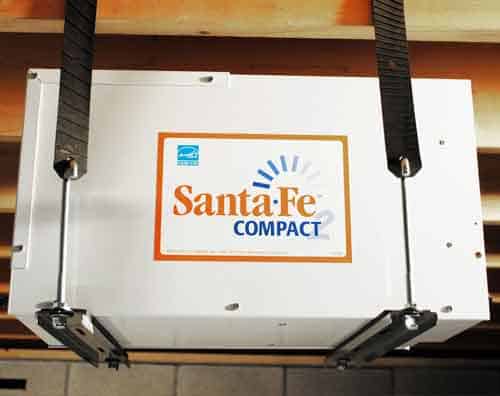The Takeaway:
1. Our Pick: Dri-Eaz Revolution LGR Dehumidifier
2. Runner-Up: Quest Dual 155 Overhead Dehumidifier
3. Value Pick: Honeywell DR90A2000 Dehumidifier
In these crawl space dehumidifier review, we analyze in detail each one of the top available solutions on the market.
We’ll talk about dehumidifying solutions in general and why dehumidifiers are the number one choice when getting rid of moisture in those parts of your house you seldom think about.
If you’re a homeowner, you already know that a million things can go awry. It usually happens when you least expect it, and if you’re not careful, the various pains of home ownership can quickly become big, expensive financial burdens.
Among the worst of these is moisture or water damage of any kind. Water damage is insidious, hard to get rid of, and its aftereffects (the damage to the structure, of course, but also the mold that moisture brings) can be tremendously expensive.
About Humidity Target
When dealing with excess moisture and humidity, the first thing we have to do is set a viable target. It’s one thing to talk about humidity in the abstract, but that’s not very helpful, so let’s put some numbers behind it. If you want to minimize the risk of mold, and wood damage, then your “sweet spot” is to keep crawl space humidity below fifty percent. Less is almost always better, but below 50% gets you out of the danger zone.
Crawl Space Dehumidifier Comparison Chart
The world of crawl space dehumidifiers is a rather small one, but even in a market with relatively few players, there are still a staggering number of choices. While this is true, we consider the following to be the top three options as Editor’s Picks. Any of these should serve your needs well, within the limitations of their specifications. We recommend though to check with the manufacturer if you have questions about their performance, given the size of your particular crawl space.
|
3.5
|
3.5
|
3.5
|
|
80 Pints/Day
|
155 Pints/Day
|
90 Pints/Day
|
|
2000 sq. ft.
|
3600 sq. ft.
|
2800 sq. ft.
|
|
12.52″W x 17.6″H x 21.5″L
|
20.25″W x 21.75″H x 38″L
|
14″W x 21″H x 33″L
|
|
66 lbs.
|
140 lbs.
|
92 Lbs.
|
Our Pick: Dri-Eaz Revolution LGR
The Dri-Eaz Revolution LGR Crawl Space Dehumidifier packs quite a punch. Measuring 17.6” high, 12.5” wide and 21.5” deep, it nonetheless weighs in at a hefty 66 pounds. Not enormously heavy, but be aware of it, because you may find it somewhat difficult to maneuver, given its lack of wheels on the base. However, as one of the smallest devices on our list, this one was picked specifically with small, cramped crawl spaces in mind.
The machine doesn’t skimp on performance, either. It treats 120 to 180 CFM (cubic feet per minute) of air, and will remove between 80 and 134 pints of water per day from the crawlspace. The display is on the front, and side mounted, which is important because, given the nature of most crawlspaces, it would be hard to read the display if it was on the top. The only downside we’ve found with the Revolution is that it can be somewhat loud. This need not be a deal breaker, however, depending on where you have it positioned.
Runner-Up: Quest Dual 155 Overhead Dehumidifier
Quest makes some of the best dehumidifiers in the business, and the Quest Dual 155 Overhead Dehumidifier is no exception. Designed for use in greenhouses or crawl spaces, you can, of course, use it anywhere there’s a need, and you’ll find a lot to like here. The unit is designed to mount overhead so that it’s out of the way and doesn’t take up valuable floor space, although it can certainly be set up at ground level if needs be.
It’s one of the quietest machines in its class, and also one of the most efficient. Most machines in this size class extract 3.8 pints per kWh (Kilowatt hour). The Quest nearly doubles that, extracting 7.3 pints for the same Kilowatt-hour of energy used. Over the life of the machine then, you can expect to save literally thousands of dollars on your electric bill for superior moisture extraction capabilities.
Speaking of moisture extraction capabilities, the Quest Dual 155 can handle just about anything you can throw at it and is capable of pulling up to 155 pints of moisture per day from the atmosphere. Even better, while it’s doing that, it’s also filtering the air, making use of a Merv 11 filtration system capable of capturing particles as small as one micron in size.
Combine this with its dual outlet design and Quest’s world-class customer service in the event that something goes wrong, and this machine is hard to beat at any price. It outperforms machines that cost considerably more. It even has an auto-restart and recovery mode in the event that you lose power. Hugely convenient, because most people don’t think to check their dehumidifier after a power outage, and with this one, you won’t need to. It’s just one less thing to worry about.
If you’re looking for a robust, efficient, cost-effective crawl space, greenhouse, or large area dehumidifier, look no further. Nearly every other Quest Dual 155 dehumidifier review from customers agrees. This is one of the best crawl space, greenhouse, and large-area dehumidifiers on the market today.
Value Pick: Honeywell DR90A2000 Dehumidifier
The Honeywell TrueDry DR90 Dehumidifier is an ideal dehumidifier for a consumer who is looking to properly eliminate excess humidity and moisture in a crawlspace or basement. It ranks as the middle of the road model in the spectrum of Honeywell’s three models of dehumidifiers. The features of the DR90 qualify it as the right balance of necessary useful elements and good value as a lasting investment.
The initial cost of the DR90 may seem slightly high at about $1,200. However, the life expectancy of this machinery is considerably longer than some of its comparable rivals. The DR90 removes up to 90 pints of water per day while still being energy efficient as well as compact. In fact, having earned an Energy Star rating of 3.0, it’s proven itself to be nearly one-third more efficient than other dehumidifiers in its class.
When using a dehumidifier on a regular basis, continual drainage is important to avoid the hassle of constant maintenance. The DR90 accomplishes this easily with its convenient ability to connect directly into a sump pump, thereby alleviating the hassle of emptying a water bucket.
The Honeywell DR90 is portable and petite enough to still provide more power and a generous 40% greater water extraction than the smaller Honeywell DR65. This allows the dehumidifier to operate optimally in an area of up to 2,800 square feet in size.
Designed to function in cooler areas, this is another advantage that deems the DR90 worth paying a little extra for, especially when being used in a crawl space area. The DR90’s adjustable humidistat, which responds to fluctuations in the humidity level, works automatically, in effect eliminating the burden of manual regulation. The unit includes a MERV 11 air filter, which is fine-tuned to destroy even the tiniest of air particles and mold spores. Additionally, Honeywell includes a five-year manufacturer’s warranty with the DR90 providing the consumer long-term peace of mind in their purchase.
For homeowners looking to eliminate harmful airborne molecules and allergens without the worry of constant maintenance, the Honeywell DR90 is a sensible, trustworthy choice certainly worthy of its price tag.
Also Great
Santa Fe Compact 2 Dehumidifier

The Santa Fe Compact 2 Dehumidifier was specifically engineered for crawl spaces and, as such, it can fit into areas where other dehumidifiers simply can’t. It is tiny compared to the other models, measuring just 12” high and 12” wide. It has no wheels on its base and weighs in at 65 pounds, so be aware of this if you’re trying to maneuver it by yourself in cramped quarters.
The Santa Fe is rated to handle moisture in crawlspaces up to 1800 square feet in size, and can remove up to 70 pints of water per day from the atmosphere. Even better is the fact that it is Energy Star compliant and manages to do this using only one kilowatt-hour per four pints of water removed. An impressive feat! When you combine this with its other capabilities, small size, and price, it’s the best all-around pick in our view.
Aprilaire 1710A
The Aprilaire 1710A Dehumidifier is an excellent model, designed with swing functionality in mind. It can serve as either a crawl space or a basement dehumidifier. Because of its dual nature, however, it may be a bit tall for some crawl spaces (its dimensions are: 20.75” wide, 24” long, and 20.75” high). Note that the unit is mounted on wheels with casters on them, which adds to the total height, and the dimensions above reflect the unit’s size with the feet fully extended.
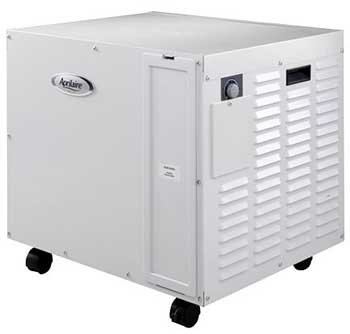
The device is quite heavy, weighing it at 93 pounds, and can treat 275 CFM (cubic feet per minute) of air. With an outstanding 5-year warranty, a wide temperature operating range (40 – 150 degrees Fahrenheit), and a washable MERV 8 air filter, it’s truly an excellent choice. The only real drawback here is the fact that it’s somewhat loud (54dB). Depending on where you’ve positioned it, this may not be a deal-breaker, but it’s definitely worth a mention.
Ebac CD85
Rugged and durable, the Ebac CD85 will serve you well in a variety of conditions. It comes standard with a ten-foot drainage hose, which should be fine for most people in most circumstances. It also has a high-capacity built-in condensate pump, which is strange, because the one downside of this unit is that it only has a capacity of 56 pints of water extraction per day, which is rather low for a machine in this class. In other words, the pump is stronger than the machine’s water extraction capacity.
It’s somewhat smaller than the machine above, with dimensions of 23.6” wide, 13.5” deep, and 15.75” high, meaning that it can fit into tighter spaces than the Aprilaire 1710A. Designed and manufactured in the UK, and made of galvanized steel, there’s a lot to like about the device. Aside from its somewhat low water extraction capacity, it will serve you very well in a variety of circumstances. The best part is the built-in humidistat, which will allow you to set your desired level of humidity. Once that level has been reached, the machine will shut off automatically, and only restart should the level begin to increase again. It is rated for up to 3000 cubic feet, but some customers have reported success with the device in larger crawl spaces than this.
Aprilaire 1850F Dehumidifier
Rated to handle moisture in crawl spaces of up to 1850 square feet (the technical specifications of the machine says it can handle spaces up to 5,000 square feet), the Aprilaire 1850F Dehumidifier is an excellent all around choice. It can treat up to 245 CFM (cubic feet per minute) of air, and remove up to 95 pints of water a day. Even better, the device has wheels mounted on casters on the base, allowing for easy maneuverability in tight spaces.
There are only two problems with the device. First, it is somewhat taller than other units. While the specifications list it as being only 17” high, this apparently does not take into account the wheels and casters, which gives it a higher profile. While the wheels are handy for maneuvering, if you’re trying to put it in especially cramped quarters, this could be an issue. Second, the digital display is top mounted. Again, if your crawlspace has limited clearance, you may need a mirror in order to actually read the display. It would have been much better to place it on the front, or one of the side panels, in our opinion.
Ebac CD60 Dehumidifier
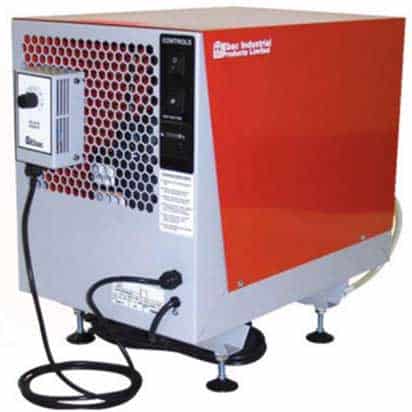
If you’re looking for a quality dehumidifier that is built to last, then look no further than the Ebac CD60 Crawl Space Dehumidifier. This solution is one of the best in the industry and is designed to remove moisture down from 33 degrees Fahrenheit in a space up to 2,790 square feet. The ideal use for this dehumidifier is in basements and crawl spaces, where moisture is always present.
Another reason why the CD60 is a great option is its energy efficiency. It is made from epoxy coated steel, which will withstand even some of the harshest conditions. It also comes equipped with the “Hot Gas” defrosting feature, which does not allow frost to build up on evaporator coils. The last thing that you want to do is constantly repair a dehumidifier, so that is one less thing that you have to worry about with this unit.
The convenience and ease of operation are what make this dehumidifier appealing to consumers. It has a standard 110v plug that can be plugged in anywhere and it only requires 2.5 amps per hour to run at full power. If you have a flooded basement or work area, then you can use the automatic condensate pump to quickly remove the water. Other convenient features include a garden hose connection, an hours run meter, and a long power cord. The internal adjustable humidistat is also a feature that you will use more than you think.
For the amount of work that this dehumidifier can do for you, it’s surprisingly compact. It weighs about 80 pounds, but it will definitely be able to get the job done. You usually get what you pay for when it comes to dehumidifiers, and the Ebac CD60 Dehumidifier is no exception. You will pay for quality and that’s exactly what you will get in return with this product.
Santa Fe Max Dry Dual XT Dehumidifier
There’s no job too big for the Santa Fe Max Dry Dual XT. It has been specifically designed for use in large crawl spaces (up to 3600 square feet), and can extract up to 155 pints of moisture under normal conditions, and up to 310 pints a day at saturation. The machine comes with a free digital humidity gauge and has a washable MERV 11 filtration system.
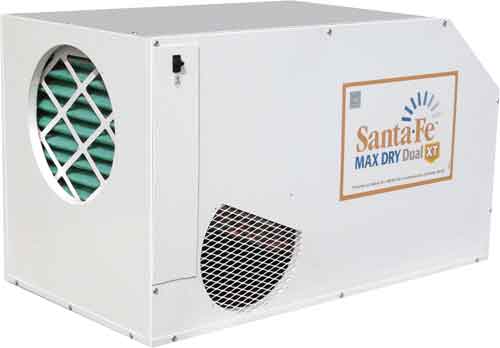
If there’s one drawback to this machine, it is the fact that it can be somewhat cumbersome to get into position. At 20.25″ wide, 21.75″ height, 38″ deep, and weighing a staggering 140 pounds. Without casters, you can imagine the potential difficulties of maneuvering this beast in close quarters. Once it’s in place, though, the machine performs just as magnificently as you’d expect all Santa Fe devices (we have selected different models from the Santa Fe line in previous reviews).
It comes with an 8’ drain hose, built-in humidistat, and an auto restart in the event of a power failure. Additionally, there are a number of options packages you can purchase to get additional functionality as needed, although with all the features that come standard on the Dual XT, you may not need any add-ons at all.
Ebac CS60 Dehumidifier
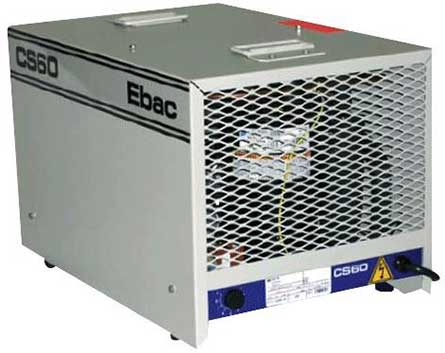
The Ebac CS60 Crawl Space Dehumidifier is a commercial grade dehumidifier that can be used in a variety of environments. It is a high capacity unit that is easy to move around. Frost build up is prevented on this device, which means that it can also work effectively at low temperatures.
Features
Pros & Cons
This unit is very sturdy and reliable and, even if a problem does occur, you should be able to carry out any maintenance yourself fairly easily. The epoxy resin coating means that it is tough enough to stand up to even the harshest environments. It is capable of removing more than 56 pints of water vapor on a daily basis.
The price of the unit is fairly high, but it does represent good value for money when you consider the features that it has. It is also likely to last several years which means that you won’t have to worry about purchasing another one in the near future.
Should I buy one?
The Ebac CS60 Dehumidifier is an excellent choice whether you are looking for a dehumidifier that remains as a stationary unit, or is moved around. It is a very durable unit that can withstand a great deal of use on a daily basis. It is an investment for your home foundations that will soon begin to pay off as you won’t need to repair any damages caused by an excess in humidity.
Ebac SPP6A Dehumidifier
It is often hard to find a dehumidifier that is both durable and reliable, but this ‘Industrial Military Grade Dehumidifier’ ticks all of the boxes. It maintains the humidity levels of any environment easily and prevents the formation of mold or mildew.
What directly appeals to many about this product is its durability. There are stainless steel fittings throughout the machine, making it less likely to rust or wear away with time. It is also shock and vibration tested, which adds to its quality.
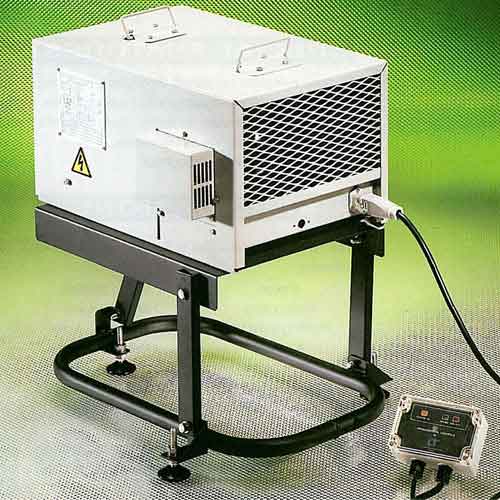
It comes with a floor stand so it can be easily set anywhere in your crawl space. This product also eliminates the build-up of frost, and the monitor box allows the operating status of the dehumidifier to be confirmed without having to enter the dehumidified area.
It is sold by Amazon and it has a 5-year warranty, which highlights that the company has your best interest at heart.
Overall, if you’re looking to buy a great quality dehumidifier, look no further.
Santa Fe Impact XT Dehumidifier
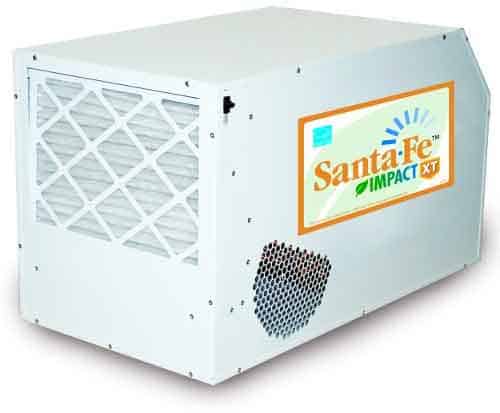
The Santa Fe Impact XT Dehumidifier is a great energy-efficient dehumidifier that boasts consuming the minimum energy requirements of the Energy Star standards by 50%. It is a free-standing dehumidifier that can remove up to 105 pints of water each day. This Santa Fe manufactured dehumidifier fits perfectly in large-sized internal spaces, like basements or crawl spaces, and it works efficiently in areas up to 2,500 square feet. It contains a dual-air distribution system that can expel the dehumidified air from either side of its design.
Families and individuals are safely breathing good air with the Santa Fe Impact Crawl Space Dehumidifier, due to its superior MERV 11 air filtration system that can capture molds, spores, and other micron-sized particles. This functional dehumidifier has a cost that makes it worth every penny, especially for a healthier environment. Another unique feature is its automatic restart. The Santa Fe Impact restarts when electricity is restored, plus it has an automatic humidity control function which gives the owner’s more control.
Crawl spaces in homes or other buildings are known to be humid and dark, which is a breeding ground for the growth of mold, mildew, and bacteria. This type of environment also holds excessive moisture which insects, like ants and termites love to make a home, which can cause damage to the structure of your home and furniture.
Drainage is a very important feature for any style dehumidifier. The Santa Fe Impact Dehumidifier features a gravity-style drainage hose that removes the need for emptying water from a container. This dehumidifier is constructed in a very sturdy manner, without a lot of unnecessary bells and whistles. It simply works hard and efficiently for large crawl spaces, as well as dehumidifying the whole house. This unique dehumidifying unit is engineered to operate quietly. The Santa Fe Impact unit has an optional pump and ducting kit that provides flexible installation anywhere you place it.
Crawl Space Dehumidifiers with Condensate Pump
Crawl space dehumidifiers with condensate pump provide a ready-made mechanism to remove the water captured from the space, extracting it safely and efficiently from the system. We’ve identified the top 3 dehumidifiers in this class, being our top pick the Santa Fe Advance 2. We’ll explain why right below, but we want to outline the strengths and weaknesses of all the top 3 models with condensate pump in order to give you a complete picture, so let’s get started!
Santa Fe Crawl Space Dehumidifier with Condensate Pump
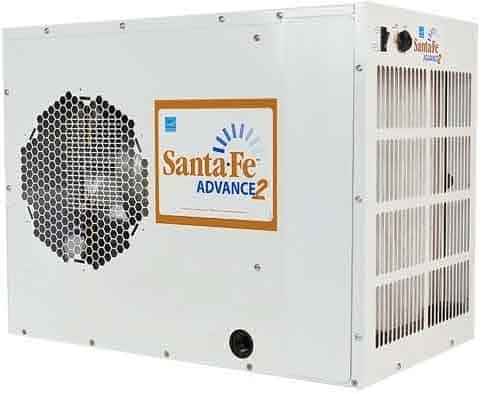
The Santa Fe 2 crawl space dehumidifier with condensate pump is the best condensate pump dehumidifier, in our view. The best thing about the entire Santa Fe line is the fact that they’re specifically engineered to fit into the tightest of spaces. Santa Fe dehumidifiers are among the smallest in the industry. This particular device is rated to handle moisture in crawl spaces of up to 2200 square feet in size.
It is Energy Star compliant, uses best in class MERV-8 filtration, and comes with an auto-restart feature (handy for after power outages, and one less thing to worry about), and unlike some models, does not struggle to operate in lower temperature environments that also have high humidity. It comes with a dual airflow outlet which doubles the air distribution. It has easy-access control switches and comes with a drainage hose. This is the perfect addition for any home that has a basement or crawl space. The Santa Fe Advance 2 also comes with ducting options for divided spaces and is very quiet. Capable of extracting up to 90 pints of water from your crawl space per day, and doing so quietly, it is the most versatile and best condensate pump dehumidifier on the market today.
Horizon Titan Crawl Space Dehumidifier – Condensate Pump

This is a great, robust unit. It’s capable of extracting up to 90 pints of water a day from your crawl space, and can treat up to 370 CFM (cubic feet per minute)) of air. It’s rated to handle a space up to 15,000 cubic feet in total size. It’s about average size and weight for a unit of this class, measuring 17” high, 13.7” wide, and 23.4” long, and weighing in at 65 pounds. The only major drawback is the fact that this is a somewhat bare bones machine. They sell optional upgrade kits allowing you to customize and add whatever additional features you may desire, but the bottom line is that you’ll almost certainly want to buy at least a few of the optional upgrades.
Dri-Eaz F515 PHD 200 Dehumidifier – Condensate Pump
Rugged, durable, and made in America, the Dri-Eaz PHD 200 Crawl Space Dehumidifier with Condensate Pump is a solid, versatile choice. This dehumidifier is comparable in size to the one above, 21.5” long, 17.6” high, and 12.5” wide, with a total weight of 63.2 pounds. It comes with a front-mounted digital display for ease of reading in cramped spaces.
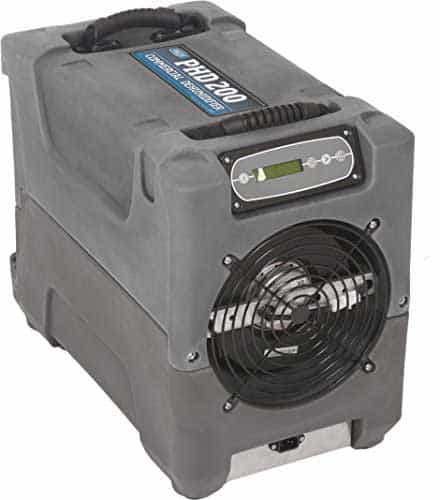
The only other drawback you’ll find with this unit is that it is somewhat louder than others in its class. Given that it will operate in a crawl space, this may or may not be a deal-breaker. If you place it under your bedroom, it could be problematic, but if you place it elsewhere under your home, it’s likely that you won’t even notice. A good, solid unit, with a 20-foot drainage hose, in addition to the condensate pump.
What Is The Best Crawl Space Dehumidifier with Condensate Pump?
The reality is that any of the machines above will serve you well, but in our view, the Santa Fe model is the best crawl space dehumidifier with a condensate pump on offer today. It is a rugged, durable machine that will serve you well.
Other Dehumidifying Options
Crawl space dehumidifiers aren’t the ONLY option available to you in terms of getting rid of excess moisture, but they are the best and most reliable method. Nonetheless, let’s take a look at some other options that some homeowners can make use of, and explain their strengths and weaknesses.
Venting
The simplest method people use is simply venting the crawl space with outside air. This is pretty simple and straightforward but comes with some major drawbacks. If you live in the southeast, or in any humid climate, it’s often going to be the case that the outside air you’re venting with will be as humid, if not more humid than the air in the crawlspace. In other words, this approach often makes things worse, not better. Even if you don’t live in an especially humid climate, any time it rains, you’re going to be venting with air containing more moisture than your crawlspace already has. It’s simple, yes. It’s just not very effective and usually winds up exacerbating the problem.

Exhaust
Here, the idea is to install ventilation fans to move the air out from under your house. The exhaust fan also has the benefit of acting a bit like a hairdryer set to no heat. The action of the forced airflow will, at least in theory, help dry your crawl space. We say “in theory” because the amount of drying that actually occurs is directly tied to the moisture in the air. Again, if you live in an area with a humid climate, and any time it’s raining outside, you can bet that the air you’re pushing is at least as humid as what’s already under the house. While this approach is at least somewhat better than passive venting, it still leaves a lot to be desired, and in vast swaths of the country, can actually make the problem worse.

If you’re going to use this method, the numbers you want to remember are 1 CFM per fifty square feet. To properly size the exhaust fan you’ll need, figure out how many square feet are in your crawlspace, divide by fifty, and that’s the fan you want. Whatever your answer is, you need a fan that pushes that number of cubic feet of air per minute to do any good.
HVAC Tie-In
With this idea, you’re taking advantage of your home’s existing HVAC ductwork, and pumping a small quantity of that air underneath your house. This option is actually fairly effective, and pretty easy to do, again, given the presence of the existing ductwork. Yes, you’ll see a nominal increase in your monthly power bill, but that’s still significantly cheaper than having to deal with moisture damage, rotting wood, and possibly mold.
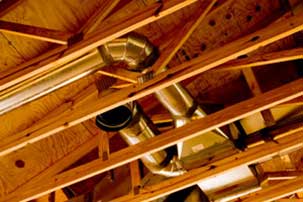
The big drawback here is that while it is pretty effective when your AC is running, it does absolutely nothing when your system’s not on. At best then, this represents a partial fix.
Crawl Space Dehumidifiers Are the Way to Go
There are lots of reasons that this is the best overall approach. The single biggest reason, though, is the fact that the dehumidifier functions based on the actual conditions under the house. That’s very different from the exhaust fan approach, which isn’t responsive to changing conditions (the fan is either on or it isn’t), or the HVAC tie-in approach, which is responsive to the conditions inside your home (it’s either hot enough in your house that you turn the AC on, or it isn’t). Having a dedicated device under the home that responds to the exact conditions found there is always going to be more effective and efficient than any other approach.
Problems And Challenges
This is not to say that you won’t face certain issues, challenges, and even technical hurdles if you opt for this approach, and these are things you should know before making the purchase. Below are some of the things you’ll want to take into account.
Conclusion for our Crawl Space Dehumidifier Reviews
Your home is your castle, and it’s constantly under siege. You can spot most of the threats fairly easily. Termites and other pests leave a visible sign that they’re knocking at (or chewing on) your door. Fire is easy to spot. The same can usually be said of clogged rain gutters or roof damage, but moisture in crawl spaces is insidious. It is every bit as destructive as the other threats we named, and in many cases, even more so.
What makes it so dangerous to your home, though, is the fact that it is largely invisible. It seeps and grows over time. It usually goes unnoticed until it’s too late. “Too late” doesn’t mean you have to tear your house down of course, but it does mean that by the time most people notice that there’s a problem, it has grown to the point that it’s going to take thousands of dollars, scores, if not hundreds of hours of your time, and lots of headaches and hassles to fix.
Fortunately, this problem is avoidable. It doesn’t have to happen to you, but in order to fix it, you’ve got to take action. You’ve got to meet it head-on and act preemptively if you want to stop moisture in its tracks. Let’s face it, there are places in our homes that we just don’t peek into very often. Crawl spaces are just such places. They deserve your attention, though, because those little nooks and crannies are usually where problems lurk.
We’ve taken very seriously the task of carefully researching all the best options for you, and we stand behind every recommendation we make. Our goal is to ensure that you’ve got all the information you need to make the best purchase possible for you and your family.
To leave you with a basic general idea: for fairly small, contained areas, a small, portable model will probably meet your needs. If your space is pretty expansive, compact models may get overwhelmed and you’ll need to consider a more powerful solution, which underscores the point of having a firm understanding of what you’re dealing with BEFORE you break out your checkbook or debit card and buy something.
References & Resources
- Aprilaire, Official Website.
- Santa Fe, Official Website.
- Honeywell, Honeywell Home.
- Ebac, Official Website.
- Damp Buildings, NCBI.
- The Inside Story: A Guide to Indoor Air Quality, CPSC.
